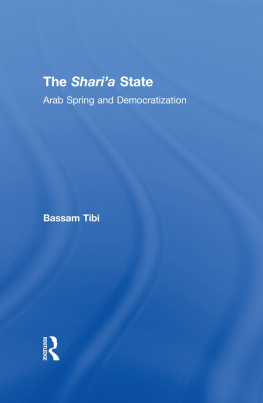ROUTLEDGE LIBRARY EDITIONS: HISTORY OF THE MIDDLE EAST
Volume 7
A History of the Arab State of Zanzibar
First published in 1978 by Methuen & Co Ltd
This edition first published in 2017
by Routledge
2 Park Square, Milton Park, Abingdon, Oxon OX14 4RN
and by Routledge
711 Third Avenue, New York, NY 10017
Routledge is an imprint of the Taylor & Francis Group, an informa business
1978 Norman R. Bennett
All rights reserved. No part of this book may be reprinted or reproduced or utilised in any form or by any electronic, mechanical, or other means, now known or hereafter invented, including photocopying and recording, or in any information storage or retrieval system, without permission in writing from the publishers.
Trademark notice: Product or corporate names may be trademarks or registered trademarks, and are used only for identification and explanation without intent to infringe.
British Library Cataloguing in Publication Data
A catalogue record for this book is available from the British Library
ISBN: 978-1-138-22002-7 (Set)
ISBN: 978-1-315-39118-2 (Set) (ebk)
ISBN: 978-1-138-22113-0 (Volume 7) (hbk)
ISBN: 978-1-315-41117-0 (Volume 7) (ebk)
Publishers Note
The publisher has gone to great lengths to ensure the quality of this reprint but points out that some imperfections in the original copies may be apparent.
Disclaimer
The publisher has made every effort to trace copyright holders and would welcome correspondence from those they have been unable to trace.
Norman R. Bennett
A History of the Arab State of Zanzibar
Methuen & Co Ltd
First published in 1978
by Methuen & Co Ltd
11 New Fetter Lane London EC4P 4EE
1978 Norman R. Bennett
Photoset by Red Lion Setters, Holborn, London
Printed in Great Britain
at the University Printing House
Cambridge
ISBN 0 416 55080 0 (hardback)
Distributed in the USA by
HARPER & ROW PUBLISHERS, INC.
BARNES & NOBLE IMPORT DIVISION
to Jeanne
Contents
My thanks go to Abdul Sheriff and Fred Cooper for their gracious permission to read their unpublished theses, and to Anthony Clayton for sending me copies of his studies on the 1948 Zanzibar general strike. I am equally grateful to Jeanne Penvenne for reading and commenting upon the manuscript, and I am even more grateful for her quick actions in saving it when an unexpected ocean breeze blew most of it out of our window in Parede. Andi Truax typed part of the manuscript with her usual thoroughness.
This study began when I had the good fortune to hold a Ford Foundation Africa Training Grant and it was helped over the years by grants by William O. Brown and A.A. Castagno, late directors of the African Studies Center of Boston University. Finally, my thanks go to the many individuals in Zanzibar who made my stay in 1959, and my visits in 1962 and 1963, both pleasant and fruitful, especially to John Gray, Salim Barwani, William and Aileen Belcher, Guy Figg and Ruth Bennett.
Nantucket and Parede , 1976
I
Early history
There is surely nothing more beautiful on earth exclaimed an early twentieth-century visitor at his first sight of the island of Zanzibar,[] Earlier Arab visitors had concurred, designating it the Green Island (Jazirat al Kuthra) because of the endless shadings of that colour presented to view. Pemba presented an even more impressive appearance than Zanzibar, its steep ridges and descending valleys providing the smaller island with a more elevated look which belied its maximum height of 311 feet.
Once ashore on Zanzibar, observers quickly confirmed their favourable first impressions. The island extends about fifty-four miles in length, along a NNW-SSE axis, and twenty-four in breadth, with a total area of approximately 640 square miles. It possesses on its western coast a fine anchoring place for sailing vessels, sheltered on all sides by coral reefs, thereby providing a secure haven at all seasons of the year. Zanzibars, and Pembas, eastern coast are open to the full force of the Indian Ocean, consequently offering no useful anchorages. The triangular-shaped peninsular where the city of Zanzibar is now located, until relatively recently virtually separated from the rest of the island at high tide, provided mariners and merchants with a safe location away from the potentially hostile populations of both the island and the African mainland. Ample provisions always were available, while Zanzibar contained what has been described as the finest water supply present between Alexandria and the Cape of Good Hope. Its former abundance of good timber also once present in Pemba additionally provided resources for the repairs often required by visiting vessels after the long and at times hazardous voyage from the distant Asian continent. In all, Zanzibar offered an ideal central location for the seaborne traders of the Indian Ocean, functioning as a port for receiving and storing of produce from the nearby mainland for eventual transfer to the sailing craft following the regular monsoon winds prevailing between East Africa and southwestern Asia and India.
Pemba, the smaller island, is about forty-five miles long and fourteen miles broad, with an area of 380 square miles, separated from Africa by a channel of between thirty-five and forty miles. Fewer vessels visited the Green Island, since it lacked satisfactory deep-water harbours, but it none the less attracted visitors because it shared many of the advantages possessed by Zanzibar. Temperatures in both islands range between the mid-70s and 80sF., living conditions being made even more pleasant by the prevailing ocean winds. The southwest monsoon winds blow from March or April to September; those of the northeast monsoon blow from November or December to March. The islands abundant vegetation is ensured by two rainy seasons: the greater rains, or masika, falling from about mid-March to the end of May in the period before the commencement of the southwest monsoon; while the lesser rains, or mvuli, fall before the beginning of the northeast monsoon, from October to December, both giving Zanzibar an annual average of from sixty to seventy inches and Pemba one of over seventy inches. This typical humid monsoon climate, normally lacking any sharp extremes of temperature or unusual variations in rainfall, naturally attracted immigrants from less-favoured regions; by the nineteenth century it provided an environment making both islands the principal source of the worlds supply of cloves.
The earliest inhabitants of Zanzibar and Pemba, because the closeness of the two islands to the African mainland made passage via small craft easy and regular, must have been of the same stock as the first East African peoples. Ancestors of the present Bantu-speaking populations of the coast probably reached this region during the first milennium of the Christian era, absorbing or displacing the then present peoples who possibly included representatives of Bushmanoid, Cushitic, or even Indonesian groupings, the latter on the long voyage from their homeland to Madagascar. And visitors from the regions of the Red Sea, Arabia, the Persian Gulf and the Indian peninsula early sailed to East Africa and its islands via the prevailing monsoon winds. The earliest surviving written documents containing information concerning East Africa, the Peri-plus of the Erythrean Sea written sometime during the first to third centuries A.D. by a Greek-speaking inhabitant of Egypts Red Sea littoral, and the Geography of the Greek scholar Ptolemy, as probably emended for East Africa during the fifth century, portray a regular and busy ]











